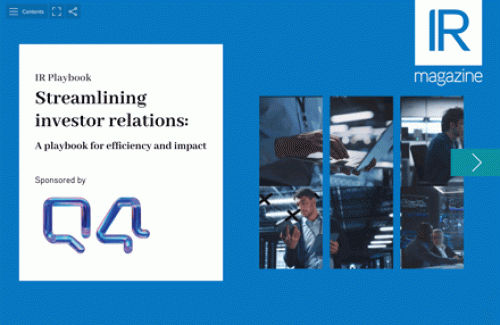Victoria Hyde-Dunn has spent most of her investor relations career at large and mega-cap companies, balancing a big pool of analysts, co-ordinating complicated and regular international non-deal roadshows with management and, increasingly, establishing a Street-friendly ESG strategy.
But last year, shortly after being named best large-cap investor relations officer at the IR Magazine Awards – US, she left Visa to join 8x8 as its head of IR. A small-cap company, 8x8 has aspirations to move into the mid-cap space. In this Q&A, Hyde-Dunn talks about how IR has grown to include ESG and has changed due to technological advancements from the investment community, as well as touching on the differences between mega-cap and small-cap investor relations.
How has IR changed during your career?
It has absolutely evolved. I think back in the day it was primarily focused on understanding companies’ financials, business drivers and overall strategy. Now it’s completely evolved into storytelling, as well as corporate governance, CSR, interactions with the board and market intelligence. When I started as an IR manager – in 2002 – I was reporting to the two heads of the IR department. I was working on tracking stock: was it up or down? What was the volume? Was there short interest? Who were we meeting with? That was IR 101.
Fast forward to today and I spend a lot of my time thinking strategically about messaging and what’s coming this quarter for my company and the industry. What are we messaging, versus our peers? Who owns us, versus our peers? Why are they selling us and our peers?
How has the conversation around corporate governance evolved during your career?
Fifteen years ago you had a couple of shareholders show up to your AGM because they wanted a coffee and a muffin. Now it’s like your senior management team and board have to be there. You have to have breakfast and registration and prepare your management team for presentations and Q&As. Then beyond the AGM, you have to engage with ISS and Glass Lewis. You have to think about putting together an ESG framework and ask yourself how you talk about it and whether you want to create a CSR report.
We did these things at Visa but even in the small-cap world it’s on my radar for next year. We’re moving toward being a mid-cap and, as you grow up in market cap, these things become more important and you get added to indexes.
Now investors want to talk about board composition, gender diversity, environmental issues and more. As a good IR person you need relationships with your legal and corporate governance team, the chairman of the board and the head of the audit committee; you need to make sure they’re all aware of shareholders’ questions. And then you need to think about corporate governance roadshows – 15 years ago you didn’t do them; you weren’t proactive on corporate governance. Nowadays you have to put together your hit list. Once the proxy is filed – or beforehand – you have to have a strategy.
We’ve seen technology dramatically change the way the markets function, with exchange-traded funds (ETFs) and high-frequency trading (HFT). How has that changed the nature of IR?
It’s definitely becoming more and more challenging to know who owns you. Even beyond ETFs, passive investors and HFT, there are 13 trading venues in the US alone. You get the 13F filings, but that’s 45 days after a transaction.
The value of IR is being able to ask a shareholder on the phone whether it still has a position in you and, if so, what it is – and it’s happy to tell you. It comes down to IR 101, working with the sell side and corporate access. This is a relationship business and you need to make sure you’re getting in front of the right investors.
You spent a lot of your career at large and mega-cap companies, but recently moved to a small cap. What have you learned about the differences between large and small-cap IR?
When I was at Visa, I would call and say the brand name and people would take my call. When I say I’m from 8x8, I have to then explain who we are and what we do. I found that I had to start with the basics of what our strategy is.
If you’re not a known brand and you’re a small cap, you don’t necessarily have the same depth and breadth of access to analysts and institutions. A lot of institutions don’t want to touch the small-cap space. I couple of months after I joined I lost coverage from one analyst. Then I put together a hit list of analysts who followed my peers and who I knew from my past role. Of those I reached out to, all bar one said, ‘Thanks for reaching out, let’s chat’. I’ve since had two analysts initiate coverage and a few more in the pipeline. As the world of sell-side coverage diminishes, I work harder to get more evangelists to help me tell our great story.
I have definitely brought a large-cap mentality to 8x8. I’m used to having about 40 analysts, conference calls every day, seeing international shareholders, bus tours and marketing with management. You have fewer opportunities as a small cap, so you have to bring your A-game to the table. My management team knows our investors well and want to see and hear from them, not me, about our strategy and what we’re doing especially we target the long-onlys over time.
You’ve been very involved in IR Magazine events and with the NIRI San Francisco chapter. What have you gained from these relationships?
I believe it takes a village inside your organization to do your job well. That why it’s important to have deep relationships with other teams in your company. And outside of 8X8, I think there’s tremendous value in networking and getting to know your peers across your sector and the IR function.
I’m a big believer in paying it forward. I had great mentors when I was younger and I’m a mentor now. It’s great to have these relationships and connections. You never know when you’re going to be faced with a problem that requires you to reach out to your network for advice.
As IR Magazine builds up to its 30th anniversary issue – the upcoming winter 2018 issue, which will be the 279th edition of the industry’s flagship magazine – we’ll be posting more throwbacks to old covers, revisiting some of the hot topics from the past 30 years of investor relations and hearing from some of the industry titans.










